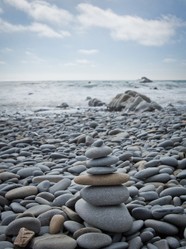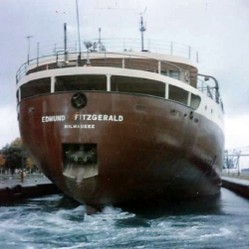The fisherfolk of Hallsands knew that the storm was coming, and they knew that it might be the end for their village. But they were tough Devon people, born and bred to the sea, whose womenfolk could haul boats up and down the shingle beach and fish with the men when required. So that night in November 1917 they sat out the storm, though children were sent for safety to relatives and friends further inland. But they did not anticipate four days of briny hell.
The villagers' forebears had chosen the site well. Situated at the foot of a sloping sandstone cliff it was separated from the sea by a ninety yard shingle beach which ensured that waves broke nearly three hundred feet from the village. Moreover, the shingle took the force of the waves and safely absorbed it. But in the 1890s in came the government. The shingle was excavated to provide concrete for a naval dockyard. The villagers' protests were in vain, the beach was stripped of much, though not all shingle, and though officialdom eventually decided to call a halt, the villagers knew that they were living on borrowed time.
The storm of 1917 lasted four days, with the mountainous waves crashing upon the village. Stone buildings began to crumble under the pounding, including the village inn, the London Inn, owned by the Prettejohns. Fortunately, they dwelt on the higher, landward side of the village, so they were spared the worst. But the villagers were forced to flee inland when storm water began to come down their chimneys. Remarkably, all the 79 villagers survived. The youngest survivor was a seven day old baby, who was transported to safety through the driving rain in a fisherman's mawn, a conical willow basket carried on the back. The Prettejohn house was one of the few that survived.
Some villagers who owned their own houses gained compensation from the government, but renters got nothing as compensation went to landlords. Many villagers moved away to safer places. But Elizabeth stayed, remaining until her death in 1964.







 TheThousand Year Garden28 days ago
TheThousand Year Garden28 days ago
 Women of the Gospelson 10/11/2025
Women of the Gospelson 10/11/2025
 Religious Gardenson 08/25/2025
Religious Gardenson 08/25/2025
 Doctor of the Church: John Henry Newmanon 08/03/2025
Doctor of the Church: John Henry Newmanon 08/03/2025



Comments
Devon lies on a basis of old red sandstone, so it's beaches and its soil have a red tinge to them.
Thank you for the alert and the information!
Online sources appear to associate Paignton beach near Torquay in Devon with pink sand. No other eastern-pond beach -- unlike the quite a few Hawaiian color-sanded beaches -- appears described as black- or green- or pink- or red- or any other-sanded.
Does Devon in fact have pink beach sand or might it perhaps be light-brown that perhaps pinkens in the sunrise or the sunset?
The beaches in Britain are mostly light brown. But don't read the Sun if you want academic quality information.
Thank you!
Online sources led me to Sun articles about black-sanded Isle of Skye and pink-sanded Devon beaches.
The former article mentions black-sanded beaches as only occurring in Iceland and in the Canary Islands. It mentions not at all the beautiful, famous black-sand beaches of the Hawaiian islands.
Might there be more colored-sand beaches in the British Isles?
In the UK almost all beaches belong to the crown or the zduchy of zcornwall which is an offshoot of the crown estate, so there are strong contrlsols on demanding.
Thank you!
De-pebbling and de-sanding can be problematic for Hawaiian beaches.
Hawaiian beaches can be black-, green- or red-sanded. The beautiful colors can be jeopardized by commercial and individual de-sanders.
Do the British Isles have colored beaches?
In some instances deshingling may be a problem , but not normally.
Thank you!
That's interesting about west-coast locations of British-Isles shingle beaches. Hawaiian equivalents, as pebble beaches, occur perhaps most desirously along west-coast Hawaii county and island.
Hawaiian pebble and sand beaches receive high marks in the beach-rated world.
Would there be a problem with British-Isles beachcombers de-shingling shingle beaches by pockets full of beach shingles?
Shingle beaches are common, particularly on the west coast.
Common.